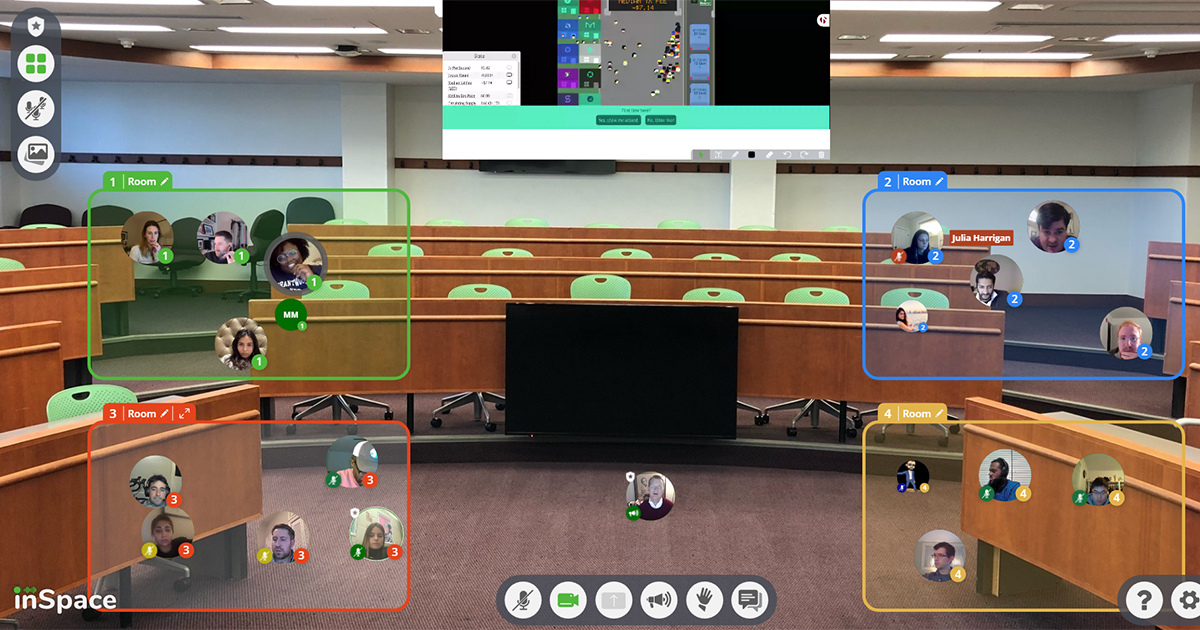Expanding Academic Toolbox Keeps Babson on Cutting Edge

Imagine small groups huddling in different parts of a classroom. You can see who’s meeting with whom, and if you wander over to that part of the room, you can hear and join the conversation.
Now, imagine leaving that classroom and randomly spotting a group of friends or colleagues chatting. You saunter over and join the impromptu discussion.
Once only conceivable in an in-person setting, these examples now are a digital reality, thanks to the new technological tools being piloted by Babson College’s Academic Technology Innovation (ATI) Center this semester.
Eric Palson MBA’09, Babson’s director of academic technologies, says tools such as InSpace—which attempts to give digital life to in-person experiences—not only improve efficiency but also help faculty create and approach their courses and help students engage with their learning. Plus, there’s more.
“It’s kind of got a cool factor to it,” Palson said of InSpace, “and that’s important because it shows the students that we care about their learning experience inside and outside of the classroom.”
Enhancing the Classroom
Babson College long has been a pioneer and leader in digital learning, dating to its first cohort of online students in 2003. The top-ranked school for entrepreneurship for more than two decades, Babson also recently was ranked 32nd in U.S. News & World Report’s specialty ranking of Online MBA programs.
So, Babson was poised last March when the pandemic forced the College to switch to remote learning, quickly transitioning 650 classes online in a week. That pivot only accelerated the adoption and embrace of a variety of existing technological tools, including Canvas, Brainshark, Webex Teams and Meetings, and others, which had been available but previously underutilized.

Lisa Keohane, associate director of academic technologies
“Babson as a whole community has learned to use these tools to improve everywhere—in the classroom, outside of the classroom, in a department, in a meeting,” said Lisa Keohane, associate director of academic technologies. “That’s been amazing for me to watch because we’ve been trying to do it for a long time.”
Since that pivotal week in March, faculty and the ATI Center have worked together to keep improving and enhancing digital learning at the College. In preparation for the fall semester, the Online Teaching Training Program trained 243 faculty members over six weeks.
“Faculty quickly realized the need to rethink their course designs to accommodate either hybrid or fully online teaching modalities,” said Professor of Management Nan Langowitz, the inaugural faculty director for Babson’s Center for Engaged Learning and Teaching (CELT).
In order to help facilitate faculty and student needs, the ATI Center continually is upgrading existing platforms, and finding and testing new tools that help enrich digital learning.
“As a technologist, I often preach about using technology to enhance the learning experience for students and teaching experience for faculty; it’s not meant to learn or teach for you,” Keohane said. “It’s been wonderful working with faculty that are making the student experience better with technology.”
“It’s kind of got a cool factor to it, and that’s important because it shows the students that we care about their learning experience inside and outside of the classroom.”
Eric Palson MBA’09, Babson’s director of academic technologies
Filling the Gaps
Over the past year, courses, meetings, and other gatherings largely have been redesigned on screens. As Babson—and the world—embraced a new virtual reality, the ATI Center has been looking for ways to better improve academic and even social experiences online.

Eric Palson MBA’09, director of academic technologies
“There are gaps that this kind of technology has when we’re all in boxes, in a grid view, side by side or up and down,” Palson said. “There are a lot of companies out there—InSpace being one that we’re excited about—that are looking at those gaps and trying to find the ways to fill, or to augment, (those experiences).”
InSpace, one of four new pilots this semester, uses spatial-audio technology to allow users to physically move their avatar to different parts of a common screen to join different simultaneous conversations. For example, a professor could move from group to group (or broadcast to the entire class), or a student could virtually move around a classroom, or even a common social space, to chat with others based on who’s already there.
“We are very excited about this product,” Palson said. “The uses for this could extend well beyond the classroom and could prove to be very useful for both cocurricular as well as social events.”
The other new pilots include:
- YellowDig is a discussion board tool integrated with Canvas, the College’s learning management system, that includes gamification and other incentives to spur conversations among students.
- Brainshark Coaching extends on the Brainshark platform with a coaching tool that allows students to record and evaluate their speaking performances based on AI and machine learning. It’s an ideal tool for sales and communication classes, as well as Rocket Pitch practices.
- Qwickly is an attendance tool to better understand who is attending classes and in which mode. Qwickly also can be extended to be a full-class participation assessment tool.
“Having the expertise and partnership of our ATI colleagues has been invaluable. It enables us to create meaningful learning experiences for our students despite the extreme challenge of the pandemic.”
Nan Langowitz, faculty director of Babson's Center for Engaged Learning and Teaching
On the Cutting Edge
The new technologies all are part of Babson’s expanding toolbox, the tools at the faculty’s disposal to address evolving needs and facilitate robust classroom experiences online. Continually refined and expanded through Babson’s Innovation Pipeline, the toolbox is a result of the partnership between the ATI Center and the faculty.
“Having the expertise and partnership of our ATI colleagues has been invaluable,” Langowitz said. “It enables us to create meaningful learning experiences for our students despite the extreme challenge of the pandemic.”

Shubham Sharma, senior research and technology specialist
That relationship and innovation has helped keep Babson on the cutting edge in a new age of digital learning. “I think we’ve been able to create a classroom experience that has been much, much better than some of the schools that we typically benchmark against from all aspects,” Palson said.
The success of Babson’s online learning has dramatically increased the confidence among faculty and others over the past year. Shubham Sharma, Babson’s senior research and technology specialist, says there is an eagerness from everyone to keep innovating and trying new things for the betterment of the students’ experience.
“The faculty actually are even more enthusiastic about trying out more tools,” Sharma said, “which could make the classroom experience more engaging than ever before.”
Posted in Community





